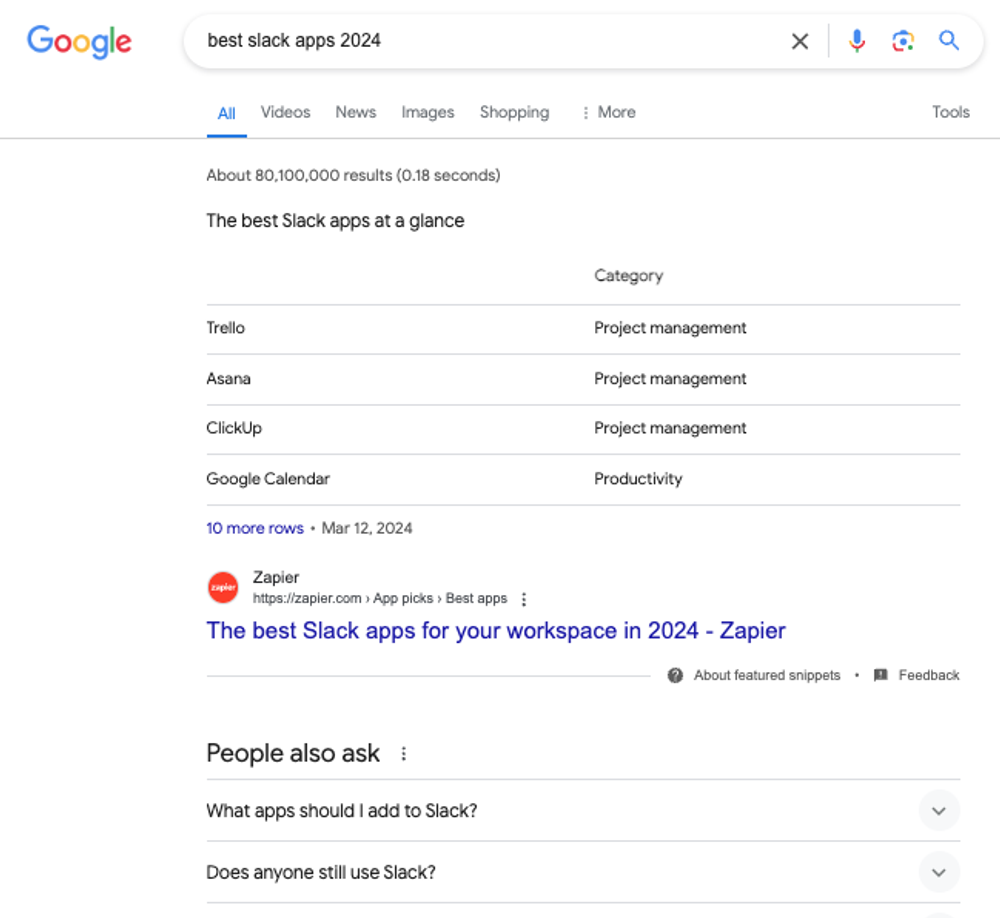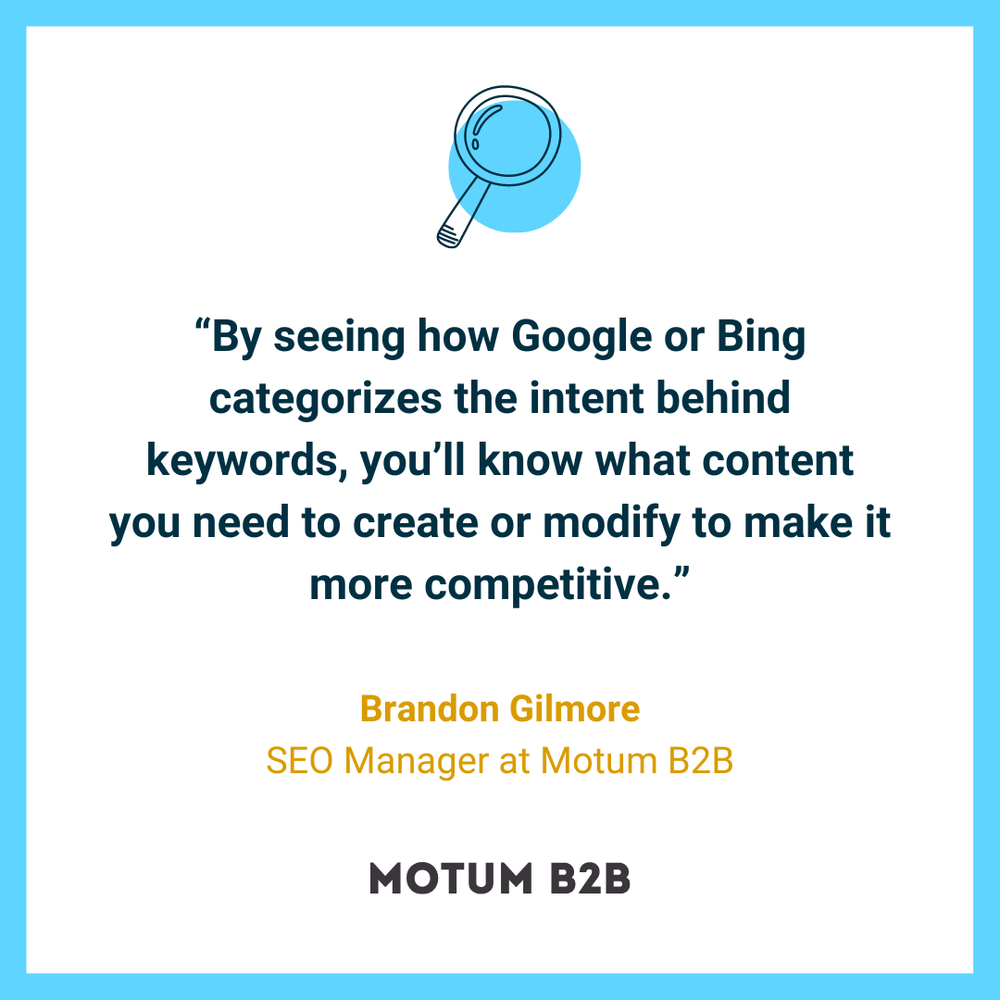Your one-stop guide to search intent
Understand what search intent is, why it’s important, and how to use it to optimize your SEO strategy as a B2B business.

Whether it’s a question, a couple of keywords, or a specific product name, search intent is the reason someone has typed something into the search engine and pressed enter.
The more you know about why someone is searching, the better you’ll be able to rank your business, products, and services as the most relevant answer.
Before we talk about the best ways to do that, it's worth understanding the different types of search intent.
Typically, there are four types:
- Informational intent, where people want to learn something.
For example: Best Slack apps - Navigational intent, where people want to find a specific page, like a login or contact page.
For example: Slack login - Commercial intent, where people want to research a product before purchasing.
For example: Slack alternatives - Transactional intent, where people want to complete something specific, such as a purchase or download.
For example: Slack trial
These four pillars form the basis of search intent and will help you define your own.
Why is search intent important?
If you want to rank better on search engines, search intent is crucial. By understanding how people are finding you, or how you want people to find you, the better you’ll be able to appeal to that intent.
Given how lengthy and complex the B2B buying journey can be in comparison to B2C — (according to a 2023 study, 75% agree that the average buying cycle time has increased in the last two years) — and how digital the process is becoming, it’s increasingly necessary to get search intent right.
If you do get it right, it’s something that can go beyond SEO to impact the way you approach content and social media strategy or the pages you include on your website.
 A search with informational intent. Notice how Google summarizes the best apps from a Zapier feature and shares what people are also asking.
A search with informational intent. Notice how Google summarizes the best apps from a Zapier feature and shares what people are also asking.
Determining search intent as a B2B brand
There are several ways to determine search intent and land on the right keywords for your business and its services.
Make the most of search engines
Brandon Gilmore, SEO Manager at Motum B2B, says to start by checking search results. “By seeing how Google or Bing categorizes the intent behind keywords, you’ll know what content you need to create or modify to make it more competitive,” he says. Google will show you what companies are ranking first but also list what questions people are also asking, which could inform other keywords and future content features.
In the same way you can do this to determine what keywords to use, you can investigate what not to use. “When a user searches for a broad keyword and the search results don’t show what you expect on the first page, it may be best to abandon it as the intent isn’t aligned with your offerings,” Brandon continues.
Think like your customers
To anticipate your customers' intent, you need to think like your customers. Especially with B2B, where searches will be specialized, specific, and solutions-oriented, it’s worth thinking about what keywords people are using to find you and how the different types of search intent fit into that.
For example, informational intent is typically happening at the start of a buying journey. What do you think people will be searching for when they start that journey? While you’ll be familiar with the technical terms associated with your B2B operation, will your customer? What do you think they’ll be searching for instead? Research matters here. Speak to your customer service department to identify questions or concerns that keep coming up and whether than can inform the thinking.
Leverage data you already have
If you’ve been putting an SEO strategy into practice, you’re already sitting on a wealth of data that you can use to inform your user intent strategy.
If people are visiting a page and bouncing quickly, are they getting all the answers they need? Why do you think they are leaving? How are people navigating your site and its content, and are they using its search bar? These are the sorts of questions to start asking.
Don’t be afraid to use SEO tools
Brandon adds that, when helping clients, he’ll typically use SEO tools to categorize keywords quickly, like ChatGPT, SE Ranking, and Semrush. “AI tools can also assist with this, but you need to be clear with your prompts.”

After you’ve put search intent into practice
Optimize your website and landing page
With better search optimization comes more clicks and visits to your website, so make sure you’re ready for that by ensuring pages are easy to navigate and optimized with keywords that reflect intent and are helping it rank in search. As part of that, include CTAs and clickthroughs to other content visitors may be interested in.
Revisit your strategy regularly
We all know that Google’s search algorithm is constantly changing. It’s been reported that it’s happening, on average, 13 times a day. Like any SEO strategy, this is something you’ll want to revisit regularly so you can make worthwhile changes. As Brandon notes, “search engines have algorithms, and the search engine results page (SERP) can and often does change regularly for keywords as they hone into the intent of users based on their behaviours.”